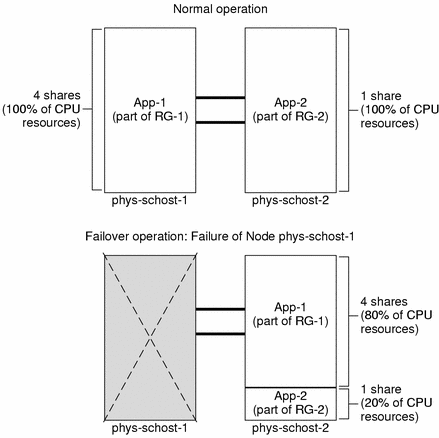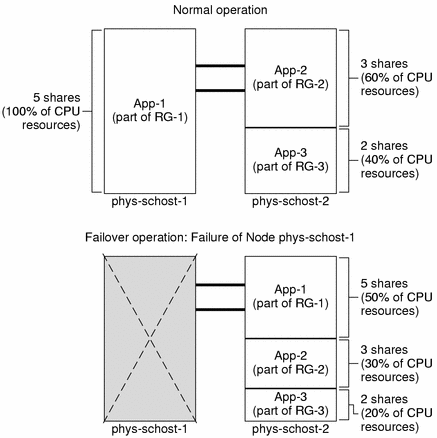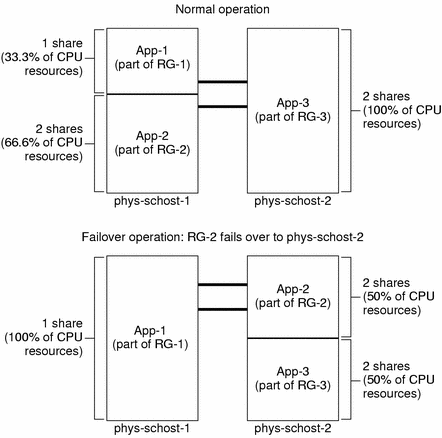Failover Scenarios
You can configure management parameters so that the allocation in the project configuration (/etc/project) works in normal cluster operation and in switchover or failover situations.
The following sections are example scenarios.
-
The first two sections, “Two-Node Cluster With Two Applications” and “Two-Node Cluster With Three Applications,” show failover scenarios for entire nodes.
-
The section “Failover of Resource Group Only” illustrates failover operation for an application only.
In a cluster environment, an application is configured as part of a resource and a resource is configured as part of a resource group (RG). When a failure occurs, the resource group along with its associated applications, fails over to another node. In the following examples the resources are not shown explicitly. Assume that each resource has only one application.
Note –
Failover occurs in the preferenced nodelist order that is set in the RGM.
The following examples have these constraints:
-
Application 1 (App-1) is configured in resource group RG-1.
-
Application 2 (App-2) is configured in resource group RG-2.
-
Application 3 (App-3) is configured in resource group RG-3.
Although the numbers of assigned shares remain the same, the percentage of CPU time allocated to each application changes after failover. This percentage depends on the number of applications that are running on the node and the number of shares that are assigned to each active application.
In these scenarios, assume the following configurations.
-
All applications are configured under a common project.
-
Each resource has only one application.
-
The applications are the only active processes on the nodes.
-
The projects databases are configured the same on each node of the cluster.
Two-Node Cluster With Two Applications
You can configure two applications on a two-node cluster to ensure that each physical host (phys-schost-1, phys-schost-2) acts as the default master for one application. Each physical host acts as the secondary node for the other physical host. All projects associated with Application 1 and Application 2 must be represented in the projects database files on both nodes. When the cluster is running normally, each application is running on its default master, where it is allocated all CPU time by the management facility.
After a failover or switchover occurs, both applications run on a single node where they are allocated shares as specified in the configuration file. For example, this entry in the /etc/project file specifies that Application 1 is allocated 4 shares and Application 2 is allocated 1 share.
Prj_1:100:project for App-1:root::project.cpu-shares=(privileged,4,none) Prj_2:101:project for App-2:root::project.cpu-shares=(privileged,1,none) |
The following diagram illustrates the normal and failover operations of this configuration. The number of shares that are assigned does not change. However, the percentage of CPU time available to each application can change, depending on the number of shares assigned to each process demanding CPU time.

Two-Node Cluster With Three Applications
On a two-node cluster with three applications, you can configure one physical host (phys-schost-1) as the default master of one application and the second physical host (phys-schost-2) as the default master for the remaining two applications. Assume the following example projects database file on every node. The projects database file does not change when a failover or switchover occurs.
Prj_1:103:project for App-1:root::project.cpu-shares=(privileged,5,none) Prj_2:104:project for App_2:root::project.cpu-shares=(privileged,3,none) Prj_3:105:project for App_3:root::project.cpu-shares=(privileged,2,none) |
When the cluster is running normally, Application 1 is allocated 5 shares on its default master, phys-schost-1. This number is equivalent to 100 percent of CPU time because it is the only application that demands CPU time on that node. Applications 2 and 3 are allocated 3 and 2 shares, respectively, on their default master, phys-schost-2. Application 2 would receive 60 percent of CPU time and Application 3 would receive 40 percent of CPU time during normal operation.
If a failover or switchover occurs and Application 1 is switched over to phys-schost-2, the shares for all three applications remain the same. However, the percentages of CPU resources are reallocated according to the projects database file.
-
Application 1, with 5 shares, receives 50 percent of CPU.
-
Application 2, with 3 shares, receives 30 percent of CPU.
-
Application 3, with 2 shares, receives 20 percent of CPU.
The following diagram illustrates the normal operations and failover operations of this configuration.

Failover of Resource Group Only
In a configuration in which multiple resource groups have the same default master, a resource group (and its associated applications) can fail over or be switched over to a secondary node. Meanwhile, the default master is running in the cluster.
Note –
During failover, the application that fails over is allocated resources as specified in the configuration file on the secondary node. In this example, the projects database files on the primary and secondary nodes have the same configurations.
For example, this sample configuration file specifies that Application 1 is allocated 1 share, Application 2 is allocated 2 shares, and Application 3 is allocated 2 shares.
Prj_1:106:project for App_1:root::project.cpu-shares=(privileged,1,none) Prj_2:107:project for App_2:root::project.cpu-shares=(privileged,2,none) Prj_3:108:project for App_3:root::project.cpu-shares=(privileged,2,none) |
The following diagram illustrates the normal and failover operations of this configuration, where RG-2, containing Application 2, fails over to phys-schost-2. Note that the number of shares assigned does not change. However, the percentage of CPU time available to each application can change, depending on the number of shares assigned to each application demanding CPU time.

- © 2010, Oracle Corporation and/or its affiliates
